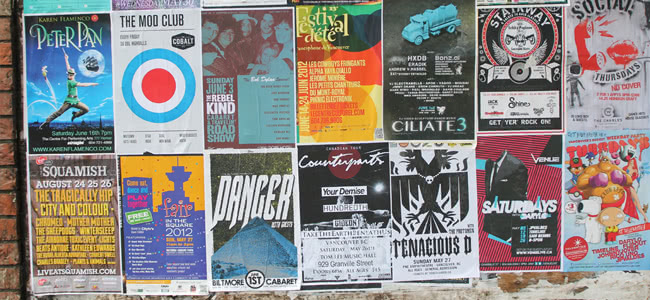Let’s say, dear reader, we asked you to design a poster for an upcoming music festival. We give you a bunch of names we have slated to play — big, small, international, local, etc. — and tell you to design the best poster you can.
How would you arrange the names in order to maximise visibility for the artists on the bill and to draw in potential punters? Would you put the biggest names at the top and the smallest at the bottom? How would you determine that?
This is the eternal struggle that faces all music festival promoters. To get the inside scoop on just how your favourite music festivals pick the lineup order on their posters, Consequence of Sound caught up with a crack team of promoters.
The team included Sean Carlson, Founder/Organizer of FYF Fest; Graham Williams, Co-Founder of Fun Fun Fun Fest; Greg Lowenhagen, Founder of Hopscotch Music Festival; and Jagi Katial, Head of Pegstar Concerts and Free Press Summer Fest.
While each promoter has their own way of doing things, and an increasing number of promoters are opting to simply go for alphabetical order, there were certain similarities true of all the promoters CoS spoke to.
For example, FYF organisers don’t start arranging the layout of the poster until all the acts have been booked and while Fun Fun Fun Fest will use placeholder names, they wait until the lineup is finished before deciding what goes where.
The decisions about poster organisation are usually decided by a small group of festival insiders with years of experience. One of their main considerations is the fact that there is no clear line dividing touring acts from local acts.
“Just because someone is a local band or a touring band doesn’t guarantee placement,” says Katial. “Especially with the Houston music scene growing as it has, we are going to have more and more touring bands who are local to Houston.”
“Governor’s Ball’s Jordan Wolowitz recalls one incident where a band refused to play an event unless they were moved up three spots on the poster.”The schedule does not necessarily dictate lineup order. Often you will have big bands playing earlier sets simply because that fits the vibe of the day, even though they may be placed high up on the festival poster.
One important though consistently contradictory factor for organisers is the use of metrics. Every single one has its own set of caveats. For example, you may want to place a band higher up on your poster because they have a lot of Facebook followers.
However, social media clout often favours younger, up-and-coming acts. As Williams of Fun Fun Fun Fest explains, when Neutral Milk Hotel headlined back in 2014, they had just sold out two nights at a 5,000-capacity venue far in advance.
“They had, like, 40,000 Facebook followers. They probably just set up their page as they had just reunited, versus some bands that have 400,000 followers and sell half as many tickets, if that,” Williams says. Ultimately, things can boil down to gut instinct.
One factor that inevitably has organisers pulling their hair out is dealing with managers and artists and their contracts. It’s for this reason that some opt to simply list bands alphabetically, taking the conversation off the table.
As Tone Deaf previously reported, the festival industry is rife with arguments over seemingly microscopic differences in font size. It may seem inconsequential, but the placement of an artist’s name on a festival poster is of extreme importance to talent buyers, acts, and agents.
While few agents will admit it, billing is ranked just below fees and time slots as a deal point for talent bookings. A band’s prominence on a festival poster can later be used to negotiate deals with other promoters, venue bookers, and the like.
Jordan Wolowitz, partner in Governor’s Ball/Farmborough producer Founders Entertainment, recalls one incident where a band refused to play an event unless they were moved up three spots on the poster. “It was kind of hilarious, actually,” Wolowitz admits.
Listing acts alphabetically may seem like the sensible solution to kill all the noise, but as Williams of Fun Fun Fun Fest explains, with a festival market that’s becoming increasingly saturated, every little variable counts.
[include_post id=”452600″]
“If you’re paying more for bigger acts, it’s because they sell more tickets than others, so why bury Yeah Yeah Yeahs at the end of your lineup because they start with a Y, but have a smaller act that starts with an A at the front?” he explains.
“People breeze through lineups, so you want the biggest stuff to be the first thing fans see when they look at a poster.” Most of the time, when fans actually take a look at a music festival poster, they’re simply baffled.
But rest assured, dear music fans, that list of band and artist names you’re looking at is far from arbitrary. More often than not there is a precise set of reasons why the lineup was arranged the way it was.
It may not always make sense to the layman music fan, but for many festivals with experience, the arrangement of their posters is the result of a great deal of time, care, and effort on the part of passionate organisers looking to give everyone the best experience.




































